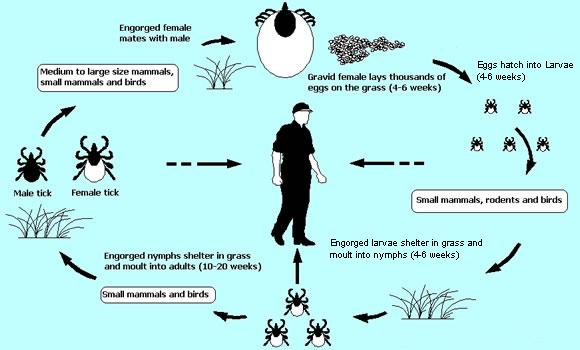Ticks can be one, two, or three-host feeders. In one-host species, all stages live and moult on the same host, eggs are then laid on the ground. In two-host species, larvae and nymphs share the same host, but the adult stage reproduces on a separate host. In three-host species, all three stages target different hosts; eggs are laid on the ground.
The life cycle of ixodids can take from 1 to 6 years and involves 4 stages: egg, larva, nymph, and adult. After hatching, the larva seeks a host, feeds, and then drops off to moult to the nymphal stage. The nymph then seeks another host, feeds, drops off, and moults to the adult stage.
A diagram of a tick’s life cycle
The majority of ixodids are classed as three host ticks and the hosts may or may not be of the same species. Ixodes ricinus ( sheep tick) usually feeds once per stage, on different hosts from a wide range of species during its life cycle. This makes it one of the most common ticks to infect livestock, domestic pets and humans. Varied host species include: mice, voles, rats, squirrels, hedgehogs, hares, badgers, foxes, carrion crows, magpies, blackbirds, starlings, pheasants, grouse, reptiles, cattle, horses, sheep, pigs, dogs, cats and humans. All stages may occur on one host concurrently.
In the life cycle of argasids, there are more than four stages: egg, larva, several nymphal stages, and adult. Nymphs have from 2 to 8 instars (stages between moults), depending on the species, and the future gender of the tick in adulthood. The number of instars can also be influenced by the state of nutrition.
Further details found by clicking on below links:-



